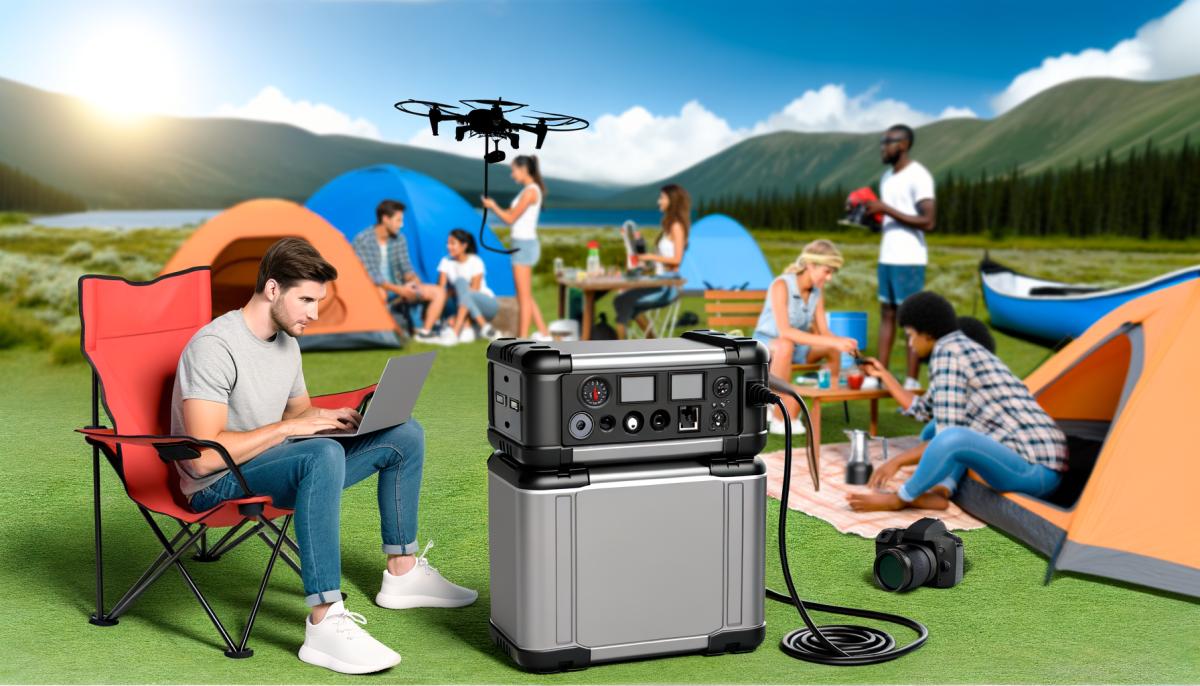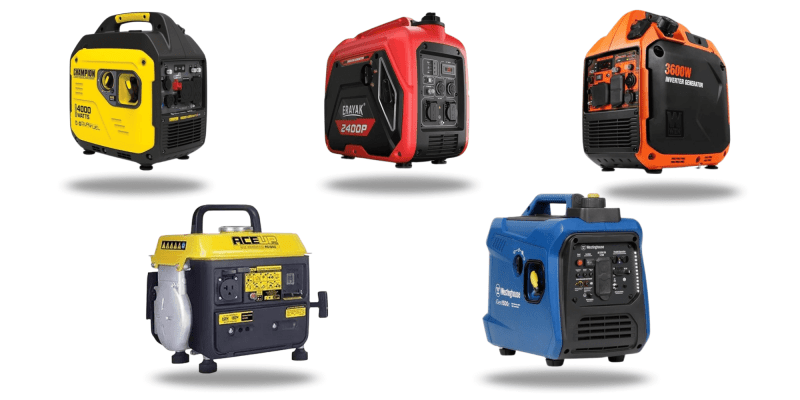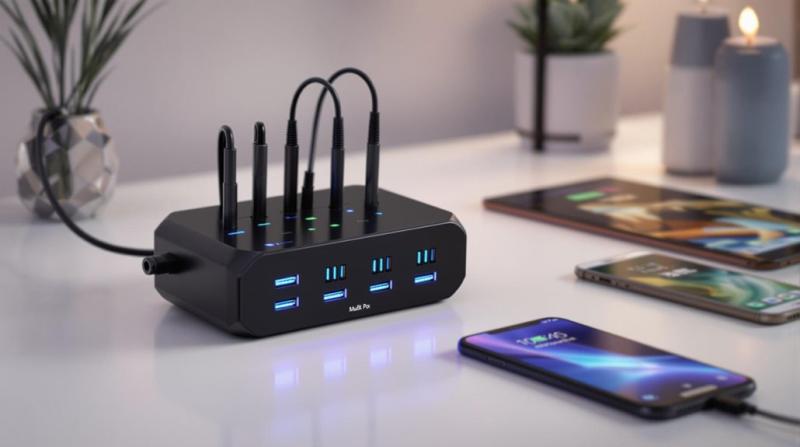To get the most out of your portable power station, start by wrapping your head around watt-hour ratings. This will help you understand how much energy your unit can actually store.
Next, take a good hard look at what you really need to power. Make a list of your devices and figure out their total wattage, always leaving a bit of wiggle room for safety.
Choosing the right battery type is super important. Lithium-ion batteries are the way to go—they last longer and are more efficient.
Don't forget to check the quality of the inverter too. Pure sine wave inverters are a must if you're planning to power sensitive electronics.
Pay attention to the charge and discharge rates as well. You don't want to overload your power station or end up with something that's not compatible with your devices.
Speaking of devices, make sure your power station has plenty of ports. You'll want a variety of outputs to keep all your gadgets happy.
Lastly, do a little homework on the brand. A good reputation for reliability and support can save you a ton of headaches down the road.
There's a lot more to think about for getting peak performance, so keep exploring your options.
Understand Watt-Hour Ratings
So, you're in the market for a portable power station, huh? Well, understanding watt-hour ratings is a biggie. These ratings tell you how much total energy the power station can store and deliver to your devices.
Watt-hours (Wh) are basically a measure of how much energy the battery can hold and dish out over time. For example, if you have a power station rated at 500 Wh, it can theoretically give you 500 watts for one hour or 250 watts for two hours. This helps you figure out if the device can keep up with your energy needs.
Now, when you're looking at those watt-hour ratings, think about the gadgets you'll be using. Each device has its own wattage requirement. Knowing this can help you decide if the power station can handle multiple devices at once.
Let's say you're planning to charge a laptop (which is roughly 50 watts) and a smartphone (around 10 watts). You'll want a power station that can comfortably handle the combined wattage of both devices.
Oh, and don't forget about energy loss during conversion from battery power to usable power! Typically, you lose about 10-20% of the energy in this process. So, if you pick a power station with a 500 Wh rating, you're realistically looking at around 400 Wh of usable energy.
Also, keep in mind the efficiency of the inverter, as it can affect the total available power too.
Assess Your Power Needs
Evaluating your power needs is fundamental for picking the right portable power station. You don't want to overload the system, right? So, let's start by listing the devices you plan to power and checking out their wattage requirements. This means looking at the specifications on each device. Wattage can vary a lot between items—think laptops, smartphones, and small appliances.
Next up, calculate the total wattage you'll need at any given time. Are you going to use multiple devices at once? For example, charging a laptop (50-100 watts) and running a mini-fridge (50-100 watts) at the same time? Your total demand can quickly hit 200 watts, depending on the devices.
Now, think about how long you'll need to power these devices. If your laptop needs to run for five hours and it consumes 80 watts, you'll need at least 400 watt-hours just for that one device. This is super important when you're looking at the capacity of different portable power stations.
Also, consider your future needs. Planning to add more devices or use higher wattage equipment later on? It's a good idea to factor that in now.
And don't forget to leave a margin of safety. You don't want to risk overloading your power station. Aim for one that exceeds your calculated needs by at least 20-30% to ensure reliable performance in various scenarios.
Consider Battery Type
When you're picking out a portable power station, it's super useful to know about the different battery types because they can really change how well the station performs and how long it lasts.
The three main types you'll come across are lithium-ion, lead-acid, and lithium iron phosphate (LiFePO4). Each has its own quirks that might sway your decision.
Lithium-ion batteries are the go-to choice in most modern portable power stations. They pack a lot of energy into a relatively light package, which is pretty awesome. Plus, they last a long time—usually between 500 to 2,000 cycles. That means you can charge and discharge them many times without them wearing out too quickly. The only downside? They can be a bit pricey upfront.
Lead-acid batteries, on the other hand, are generally cheaper. But there's a catch: they don't last as long, often only around 200 to 300 cycles. They're also heavier and bulkier, which isn't great if you need something portable. Still, if weight isn't a big deal for you or you're on a tight budget, they could be a decent option.
Then there's lithium iron phosphate (LiFePO4) batteries. These are kind of the best of both worlds. They last longer than lead-acid batteries, often going beyond 2,000 cycles, and they're safer with a lower risk of catching fire. That said, they can be a bit more expensive than the standard lithium-ion batteries. So, you'll need to weigh those pros and cons.
Look for Inverter Quality
Inverter quality is super important when it comes to making sure your portable power station can effectively convert DC power from the battery into the AC power your devices need. A good inverter means stable and reliable power, which is essential for sensitive electronics like laptops, smartphones, and medical equipment.
When you're checking out inverter quality, it's best to go for pure sine wave inverters instead of modified sine wave ones. Pure sine wave inverters give you cleaner, more consistent power that mimics what you'd get from your home grid. This helps keep your devices performing well and lasting longer.
Oh, and don't forget to check the inverter's total wattage rating. This tells you how much power the inverter can handle at any given time. If you're planning to run multiple gadgets at once, make sure the inverter's capacity is higher than the combined wattage of all the devices you want to power up.
Another thing to keep in mind is the inverter's efficiency. A more efficient inverter will turn more of the stored battery energy into usable AC power, reducing waste and extending battery life. Aim for inverters with efficiency ratings above 85%.
And one more thing—check out the inverter's built-in protection features. Overload, short-circuit, and thermal protection can prevent damage to both the inverter and your devices, making everything safer to use.
Check Charge and Discharge Rates
Understanding the charge and discharge rates of your portable power station is super important for getting the best performance out of it and making sure it meets your energy needs efficiently. So, let's break it down a bit.
Charge rate? That just means how quickly you can refill the power station, usually measured in watts. If the charge rate is high, you can get back to using your gadgets sooner. This is a lifesaver during emergencies or if you're, say, camping for a long time.
On the flip side, the discharge rate tells you how fast the power station can supply energy to your devices, also measured in watts.
Now, to make smart choices, compare these rates to what you actually need. For example, if you're thinking about powering a high-wattage appliance, make sure the discharge rate of your power station can handle it without overloading.
Also, the type of battery matters. Lithium-ion batteries usually have better charge and discharge rates compared to lead-acid ones.
It's a good idea to calculate your total energy consumption for what you'll be using. If you're running multiple devices at once, add up their wattage and see if the power station's discharge rate can keep up.
This way, you won't drain the battery too quickly or run into charging issues. Knowing these rates helps you get the most out of your power station, keeping your devices powered up efficiently and reliably.
Evaluate Port Availability
Evaluating the port availability on your portable power station is super important to make sure it can handle all your devices without a hitch. When you're checking out the ports, pay attention to the types and numbers available. Most portable power stations will have a mix of AC, USB, and DC outputs. You'll need to figure out how many of each type you need based on what devices you're planning to power up.
So, if you've got multiple smartphones, tablets, or laptops to charge, make sure the power station has enough USB ports. Some models even come with USB-A and USB-C options, which are awesome for fast charging newer gadgets.
And don't forget to check the number of AC outlets. If you're looking to run larger appliances or multiple devices at the same time, having more outlets is definitely a good idea.
Now, think about the power ratings for each port. Some devices need higher wattage to charge or run efficiently. Plugging a high-wattage device into a port that can't handle it can overload the power station or even damage your gear. Not cool, right?
Lastly, take a look at the layout of the ports. Make sure they're spaced out well, especially if you have some bulky plugs. A cramped design can really limit your ability to use all the ports effectively.
Research Brand Reputation
Sure, making sure your portable power station has the right ports is super important. But hey, don't forget to check out the brand's reputation too! It can really give you the lowdown on how reliable and efficient it's over time. If a brand's been around for a while, that's usually a good sign they know what they're doing and people are happy with their stuff.
So, dive into some reviews and testimonials from folks who've actually used the power station in real-life situations. It's a great way to see how it holds up, especially when things get tough, like during long usage or crazy weather.
Oh, and don't skip looking into their customer service history. Trust me, a company that's got your back with solid support can be a lifesaver if something goes wrong. Check out their warranty policies and whether it's easy to get replacement parts. A longer warranty usually means the manufacturer is pretty confident their product is built to last.
Another thing, see if the brand has any certifications or industry awards. Those can be a good indicator that they're committed to quality and innovation. Certifications from well-known organizations can also reassure you that the power station meets certain safety and performance standards.
Lastly, don't just rely on one source for your info. Compare the brand's reputation across multiple platforms. Look at review sites, social media, forums—you name it. This will give you a better overall picture of customer sentiment and help you spot any recurring issues with the brand or specific models.
All in all, doing a thorough check on the brand's reputation can really help you make a smart choice when investing in a portable power station.



